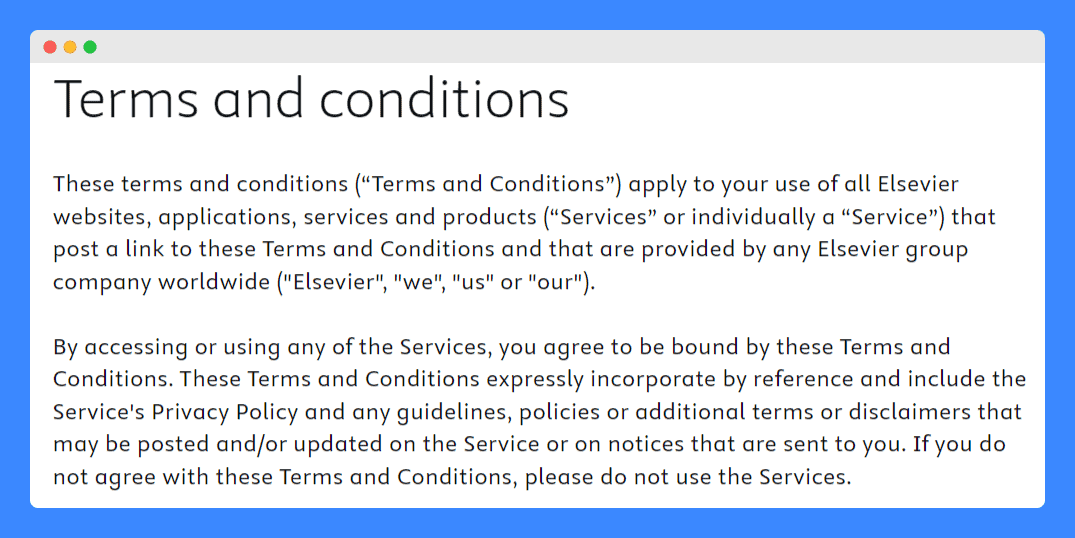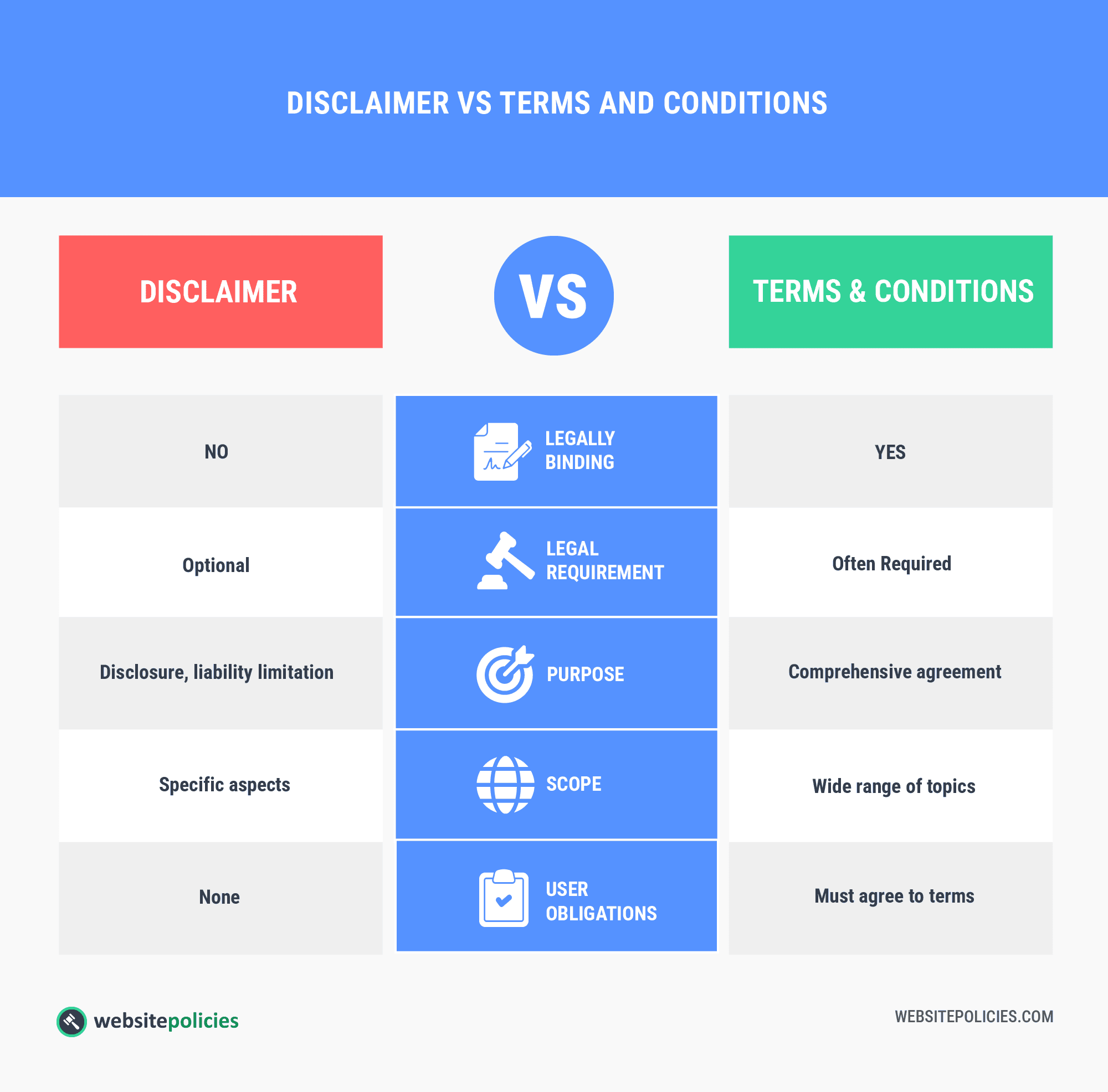Many website owners use the terms “disclaimer” and “terms and conditions” interchangeably. While they both serve important purposes, they have distinct roles.
At their core, disclaimers are statements that limit your liability by spelling out certain risks or limitations associated with your website or product.
On the other hand, terms and conditions are comprehensive rules that let users know what is expected of them and what they can expect from your service. Together, they form the backbone of your site’s legal framework.
As an online business owner, you must know the difference between a disclaimer vs terms and conditions to ensure compliance with relevant laws, protect your business from disputes, and maintain a positive relationship with your customers.
- Your disclaimer limits legal risks associated with your services. It’s essential for protecting your business.
- Terms and conditions govern how users interact with your site. They ensure you’re compliant with the law.
- Customizing these documents to your business specifics ensures they effectively address your unique needs.
Table of Contents
PRO TIP: Take the hassle of writing your own disclaimer away with our disclaimer generator trusted by over 200,000 businesses. It’ll save you hours of work and possible costly legal mistakes.
What Is the Purpose of a Disclaimer?
A disclaimer is a statement used to reduce the legal risks associated with a product or service. Essentially, it explicitly clarifies what the business is not responsible for.
Disclaimers come in various forms tailored to specific needs. Here are some of the most common:
- Legal Disclaimer: This type of website disclaimer protects against liabilities arising from website content. Implementing this disclaimer is crucial if you post content that may be interpreted as legal advice.
- Medical Disclaimer: This disclaimer type informs users that the content is not medical advice but for educational purposes only.
- Affiliate Disclaimer: This disclaimer reveals the presence of affiliate links and ensures transparency about earning commissions from third-party products.
- Warranty Disclaimer: Whenever you sell or promote items, you need this disclaimer to safeguard your business against unfair warranty claims.
In short, disclaimers help clarify how businesses collect and process personal information. They also help disclaim any liability for misunderstandings or misapplications of the information.
Here’s an example of a general website disclaimer from the US Department of Interior:

PRO TIP: When writing a disclaimer, include a limitation of liability clause to address risks associated with third parties. This is important if your website relies on content from external sources.
What Is the Purpose of Terms and Conditions?
Terms and conditions, often referred to as terms of service or terms of use, are the rules that govern how users can use your website or app. They form a legal contract between the service provider and the user that must be agreed upon to access the website.
A terms and conditions agreement often includes:
- Specific guidelines or rules for using the site (what is allowed and what is prohibited on your platform)
- Privacy rights of your site visitors, such as details on how user data (like credit card information) is handled, especially for marketing purposes
- How users can agree to the terms to use the services provided
- The dispute resolution process to handle conflicts between the service provider and the users
In my experience running my business, I learned that these elements help ensure both parties understand their rights and obligations. They have also provided a clear framework for the use and operation of my website or app.
For instance, to show transparency, I make sure to include similar details as Elsevier did in its Terms and Conditions document:

With a terms and conditions agreement, you can help limit your legal liability, protect your intellectual property rights, and establish clear expectations with your users.
Disclaimer vs Terms and Conditions Comparison
Understanding the difference between disclaimers and terms and conditions was one key factor in helping me build my online business. To help you do the same, here is where each one fits into the bigger picture and why they are both important:
1. Legally Binding Nature
Disclaimers are not always legally binding but serve as a precautionary statement that helps limit your liability, such as those associated with errors and omissions or the use of your goods or services.
On the other hand, the terms and conditions are a legally binding agreement that sets forth the rules users must follow to interact with the website or app.
2. Legal Requirements
A disclaimer is generally not required but highly recommended to safeguard against potential legal claims and clarify a business’ scope of responsibility.
In comparison, a terms and conditions agreement is legally required for websites that collect personal data. It helps ensure online privacy protection and meets various compliance standards.
3. Scope of Content
Disclaimers focus on limiting liability for specific issues like content accuracy and third-party links.
A website’s terms and conditions provide a more comprehensive coverage. This includes user behavior, payment terms, disclosure of data usage, and the dispute resolution process.
4. User Interaction
Typically, a disclaimer does not dictate how users should interact with the website. Rather, it makes them aware of the limitations and exclusions regarding the content and services provided.
That said, the terms and conditions page is where you outline how users should engage with the site.
In my case, it is where I specify what actions are permissible and the consequences for violations. This is so that potential customers know how to interact with my website responsibly and are aware of the rules upfront.
Here’s an overview of their differences:

Can a Disclaimer Be Included Within a Terms and Conditions Document?
Yes, a disclaimer can be included within a terms and conditions document. This consolidation helps streamline common legal policies.
They can also be placed in various locations besides the terms and conditions to ensure users can easily find them. Common practices include:
- Footer of a Website: Often, websites include disclaimers in the footer where they are accessible from every page to enhance visibility.
- Product Pages: For eCommerce sites, disclaimers about products can be displayed on individual product pages to inform consumers about potential limitations.
- Legal Documents: Including disclaimers in contractual legal documents provides clarity and reinforces legal boundaries with clients or partners.
Positioning disclaimers strategically across different areas ensures comprehensive coverage and understanding, reinforcing legal protections effectively.
Why Do You Need Both Disclaimer and Terms and Conditions for Your Business?
You need a disclaimer and terms and conditions for your business to cover different legal bases. Not having both can put your business at risk for non-compliance with privacy laws and potential miscommunications about user rights and obligations.
- Compliance With Applicable Privacy Laws: When used alongside privacy policies, they help you comply with data protection standards like the GDPR.
- Adherence to FTC Regulations: Both help businesses adhere to guidelines set by the Federal Trade Commission. In turn, they can prevent potential legal actions from state or federal levels.
PRO TIP: To streamline the process, consider using a free terms and conditions generator. These tools can help you generate customized documents that meet legal requirements.
Frequently Asked Questions
How do disclaimers and terms and conditions affect my business’s reputation?
Disclaimers and terms and conditions boost your business’s reputation and user trust by showing your commitment to legal compliance.
Can I use a template for my disclaimer and terms and conditions?
Yes, you can use templates for disclaimers and terms and conditions. make sure you tailor them to your specific business needs.
Can I copy a disclaimer and terms and conditions from another website?
Copying directly from another site is risky and not advised. Tailor documents to fit your specific business needs and legal requirements.
How can I ensure my disclaimer and terms and conditions are legally compliant?
Consult with a legal expert to tailor your documents. Regularly update them to keep pace with changing laws and business practices.
Do disclaimers and terms and conditions need to be tailored to my specific business?
Yes, disclaimers and terms should be specific to your business. Customizing them ensures they address your unique legal and operational needs.




